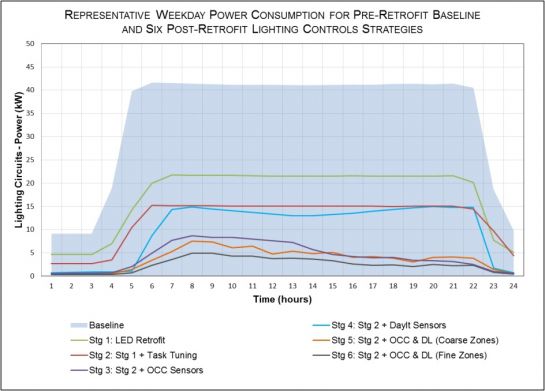Go inside and look up, and you’ll see the future network nodes of an entire intelligent building infrastructure shining down on you.
Lights are a logical, ubiquitous building feature to use for embedded wireless connectivity, environmental and occupancy sensors, and a whole host of other smart building features. The rise of LED lighting brings lots of opportunity to package energy-saving features and controls, as well as a platform that can provide all-important data to smart building applications.
Finally, these lights could eventually connect to everything else in the building -- HVAC systems, elevators and escalators, emergency and security systems, even desktop PCs and smartphones -- to take on the role of a general building network. At least, that’s how Brian Chemel, CTO and co-founder of networked LED startup Digital Lumens, sees the path forward for smart lighting.
“We sum it up with the idea of intelligence everywhere,” Chemel said. On Tuesday, Digital Lumens launched its latest set of smart lighting technologies, including new lights, new network nodes, and its new LightRules Insight software platform to bring networked lighting data into play across building portfolios.
Digital Lumens has installed networked LEDs in 1,000 projects covering about 100 million square feet of industrial and commercial building space, most of it highbay industrial-style lighting. Tuesday’s launch includes a new LED tube fixture to replace fluorescent tubes commercial spaces, as well as a new line of “Digital Light Agents” -- a family of control adapters and sensors that can be retrofitted to existing lights.
“This is basically the fourth platform we’ve designed over the past six years,” he said. “There have been two big narratives on the product side. One is, of course, that LEDs are getting cheaper and more efficient, and the other is that the incremental cost of intelligence has come down really fast.”
Digital Lumens’ new agent devices use the same light sensor chip sets that today’s smartphones use, for example. “The billions of handsets around the world have made a class of hardware really stupid cheap,” he said, which has made the smarts in smart lighting transform from “a really pricey add-on to a rounding error,” he said.
Digital Lumens’ LightRules Insight is where all these networked nodes get put to use. Since emerging in 2008, the Boston-based company has implemented its networked LEDs on a building-by-building basis. Tuesday’s launch brings the ability to manage multiple sites from a common platform, with “energy normalized by factors that matter to them -- degree days, or throughput if it’s a manufacturing facility -- to ask questions like why a facility’s lighting usage is 40 percent higher or lower than the rest,” said Chemel.
That could bring additional value to a platform that’s already squeezing a lot out of lighting energy, which typically makes up about a quarter of building energy usage. In a pilot project with utility Pacific Gas & Electric and Ace Hardware, the company found it could squeeze 93 percent out of the previous lighting energy use through scheduling, occupancy controls, daylighting adjustments, and “task-tuning” lighting schedules via feedback from its sensor data analysis, compared to the 49 percent efficiency gain from installing LEDs without controls.

“What we increasingly find is that you really need all four of these strategies simultaneously,” he said. “Our secret sauce is to combine those strategies, controlled by software so they’re easily adjustable on the fly, and then roll them all up, and turn them into actionable insights for the energy manager.”
Similar concepts are driving a whole new ecosystem of smart lighting products into the market, whether it’s coming from LED and lighting systems manufacturers like Philips, General Electric, Bridgelux and Cree, to startups like Daintree Networks, Enlighted and others.
And because these sensors are spread out across every floor of a building, they’re also invaluable intelligence for squeezing more efficiency out of day-to-day operations from the building at large. Digital Lumens, for example, launched its LightRules Power product last year to manage meter and submeter data within buildings.
Digital Lumens is also opening up its API to allow partners to write applications to interact with its data, and is looking at ways it can stand in for traditional building management system functions like HVAC control in smaller buildings that can’t afford their own BMS. “As we move into new spaces, having LightRules be able to play well with those other systems is important,” said Chemel.



